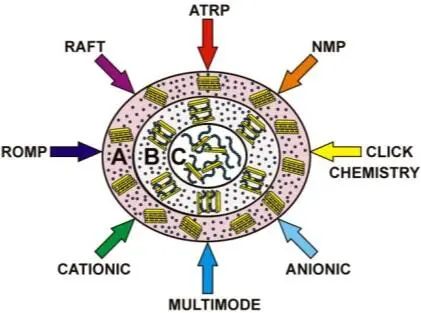Коллектив авторов - Международная молодежная научная школа «Школа научно-технического творчества и концептуального проектирования»
- Название:Международная молодежная научная школа «Школа научно-технического творчества и концептуального проектирования»
- Автор:
- Жанр:
- Издательство:Литагент БИБКОМ
- Год:2012
- Город:Казань
- ISBN:978-5-7882-1300-2
- Рейтинг:
- Избранное:Добавить в избранное
-
Отзывы:
-
Ваша оценка:
Коллектив авторов - Международная молодежная научная школа «Школа научно-технического творчества и концептуального проектирования» краткое содержание
Международная молодежная научная школа «Школа научно-технического творчества и концептуального проектирования» - читать онлайн бесплатно ознакомительный отрывок
Интервал:
Закладка:
1. Visser, A. E., Swatloski, R. P., Reichert, W. M., Mayton, R., Sheff, S., Wierzbicki, A., Davis, J. H., Rogers, R. D. Environ. Sci. Technol. 2002, 36 (11), 2523–2529.
2. F.M. Gray, Solid Polymer Electrolytes, VCH, New York, 1992.
3. A.M. Anderson, C.G. Granquist, J.R. Stevens, Appl. Opt. 28 (1989) 3295.
4. M.B. Armand, Ann. Rev. Mater. Sci. 16 (1986) 245.
5. C.A.Vincent, Prog. Solid State Chem. 17 (1987) 145.
6. M.Watanabe, N. Ogata, Br. Polym. J. 20 (1988) 181.
7. M.A. Ratner, D.F. Shriver, Chem. Rev. 88 (1988) 109.
8. D.E. Fenton, J.M. Parker, P.V. Wright, Polymer 14 (1973) 589.
9. M.B. Armand, J.M. Chabagno, M. Duclot, 2nd International Conference on Solid Electrolytes, St. Andrews, 1978, p. 651.
10. C.A. Bruce, P.G. Vincent, Trans. Faraday Soc. 89 (1993) 3187.
[11] G.B. Appetecchi, F. Croce, B. Scrosati, J. Power Source 66 (1997) 77.
12. O. Savadogo, J. New Mater. Electrochem. Syst. 1 (1998) 47.
13. Marcilla, R., Blazquez, J. A., Rodriguez, J., Pomposo, J. A., Mecerreyes, D. Journal of Polymer Science Part A: Polymer Chemistry 2004, 42 (1), 208–212.
BIODEGRADABLE POLYMERS FOR TISSUE ENGINEERING APPLICATIONS
Tissue engineering is an interdisciplinary field that blends classical engineering and the life sciences to repair or replace damaged tissues. The most common strategy to achieve this goal is to culture of patient’s own cell onto a three dimensional support matrix, so called scaffold, and then implant this construct to the patient. The function of a degradable scaffold is to act as a temporary support matrix for transplanted or host cells so as to restore, maintain, or improve tissue. The design of a polymeric scaffold plays a significant role in proper cell growth. Therefore, several important properties must be considered: fabrication, structure, biocompatibility, biodegradability, and mechanical strength.
Scaffolds may be created from various types of materials, including polymers. There are two sources of polymers used in tissue engineering: synthetic and natural. The main biodegradable synthetic polymers include polyesters, polyanhydrides, polyorthoesters, polycaprolactone, polycarbonate, and polyfumarate, while the natural origin polymers include collagen, alginate, agarose, hyaluronic acid derivatives, and chitosan. Among the man-made polymers, polyglycolide, polylactides, poly(caprolactone), and poly(dioxanone) constitute the major polymer groups that have been studied as matrix materials.
Natural polymers are typically biocompatible and enzymatically biodegradable. The main advantage for using natural polymers is that they contain bio-functional molecules that aid the attachment, proliferation, and differentiation of cells. However, disadvantages of natural polymers do exist. Depending upon the application, the previously mentioned enzymatic degradation may inhibit function. Further, the rate of this degradation may not be easily controlled. Since the enzymatic activity varies between hosts, so will the degradation rate. Therefore it may be difficult to determine the lifespan of natural polymers in vivo. Additionally, natural polymers are often weak in terms of mechanical strength but cross-linking these polymers have shown to enhance their structural stability.
Polymers that are chemically synthesized offer several notable advantages over natural-origin polymers. A major advantage of synthetic polymers is that they can be tailored to suit specific functions and thus exhibit controllable properties. Furthermore, since many synthetic polymers undergo hydrolytic degradation, a scaffold’s degradation rate should not vary significantly between hosts. A significant disadvantage for using synthetic polymers is that some degrade into unfavorable products, often acids. At high concentrations of these degradation products, local acidity may increase, resulting in adverse responses such as inflammation or fibrous encapsulation.
There are several methods to produce 3D scaffolds from polymers, such as particulate leaching combined with compression moulding or solvent casting, freezing drying, fiber bonding, electrospinning and rapid prototyping, etc.
Particulate leaching is an inexpensive method based on dispersing certain size particles within a polymeric solution or fine polymer powder and then moulding this mixture by solvent casting or compression moulding techniques. The final porous stucture is achieved by removal of porogen from polymeric construct.
Freeze-drying is the most common and simple method to produce scaffolds, especially from natural polymers. The scaffolds, with different pore size and porosity, can be formed by the simple procedure of freezing a polymer solution in a suitable mould and subsequently lyophilizing the frozen structure. The freezing process provides the nucleation of ice crystals from solution and further growth along the lines of thermal gradients. Ice removal by lyophilization generates a porous material.
Fiber-based scaffolds can be obtain with fiber bonding followed by commercial fiber production methods, such as melt spinning, dry spinning and wet spinning.
Electrospinning is a relatively simple and efficient method to produce polymeric fibers on a nano scale. It has been used in polymer processing technology for more than 70 years and recently had much attention from the biomedical field, particularly in tissue engineering due to the structural properties of fabricated fibrous structures having diameters in the range close to the collagen fibers found in the natural extracellular matrix of about 30–130 nm.
Rapid prototyping is a common name for a group of techniques, such as fused deposition modeling (FDM), laminated object manufacturing (LOM), three-dimensional printing (3DP), multiphase jet solidification (MJS) and 3D plotting, that can generate a physical model directly from computer aided design data. It is an additive process in which each part is constructed in a layer-by-layer manner. This technology allows one to produce a complex 3D structure of scaffolds with controlled architecture which means desired pore size, porosity and pore distribution.
POLYMER/CLAY NANOCOMPOSITES BY IN SITU METHODS
Polymer/clay nanocomposite materials, in which nano-sized silicate plates of clay are uniformly dispersed in the polymer matrix, exhibit superior physical properties such as high dimensional stability, gas barrier performance, flame retardancy, and mechanical strength that cannot be achieved by pure polymer or conventional composites (micro- and macro composites) [1-3]. Furthermore, polymer layered silicate nanocomposites (PLS) avoid processing techniques (e.g. extrusion) which are used for materials with a higher content of reinforcement. This polymer/clay nanocomposites can be prepared in several ways, namely, solution exfoliation, melt intercalation, in situ polymerization and template synthesis [4]. Solution exfoliation can be only used with water-soluble polymers to produce mostly intercalated nanocomposites, because of the need of large amounts of solvent to ensure a good clay dispersion [5]. Melt intercalation is a solvent-free method which enables mixing of the layered silicate with the polymer matrix in the molten state. However, very careful attention has to be paid to finely tune the processing conditions to increase the compatibility of clay layer surfaces with the polymer matrix. In the in situ polymerization technique, the monomer, together with the initiator and/or catalyst, is intercalated within the silicate layers and the polymerization is initiated by external stimulation such as thermal, photochemical or chemical activation [6-10]. The chain growth in the clay galleries triggers the clay exfoliation and hence the nanocomposite formation. Unlike melt intercalation, the low viscosity of the monomer (if compared with the polymer) in the in situ polymerization makes it more easy to break up particle agglomerates by using high shear devices, resulting in a more uniform mixing of particles in the monomer. In template synthesis clay layers are formed by crystallization in an aqueous polymer gel. However, the layers show a limited length and the size are not comparable to pristine clays. Furthermore, it is possible to control nanocomposite morphology through the combination of reaction conditions and clay surface modification.
Since the discovery of polymer/clay nanocomposites by the Toyota research group [11] in the early 1990s, over 5.000 papers have been published up to now with the concept of clay as filler for polymer matrices. In the work of the Toyota group, ε-caprolactam monomers were polymerized between silica layers resulting in polyamide/clay nanocomposites showing highly improved thermal rheological and mechanical properties of the polymer.

Fig 1. Schematic representation of polymer/clay nanocom posites by various in situ polymerization techniques (A. monomer immersion, B. intercalation, C. exfoliation).
Various different living and controlled/living polymerization methods were used in the production of well-dispersed silicate layers, including atom transfer radical polymerization (ATRP) [12-20], nitroxide mediated polymerization (NMP) [21,22], and reversible additionfragmentation chain transfer (RAFT) polymerization [23-26] , ring-opening polymerization (ROP) [27-32], ring-opening metathesis polymerization (ROMP) [33-35] , living cationic polymerization [10,36] and living anionic polymerization (Figure 1) [37,38]. The common approach throughout the literature is to immobilize polymerization initiators in between the clay layers. This can be done by replacing the cations of the clay surface with silane coupling agents or with organic salts, mainly quaternary ammonium salts which comprise functional groups. During the polymerization step the layers exfoliate and a highly dispersed nanocomposite can be gained [22].
In this presentation, we will focus on the recent progress of the in situ synthesis of polymer/clay nanocomposites with well-defined structures and highly exfoliated morphologies. The methods used for the preparation were classified according to the individual polymerization mechanisms. Other possibilities such as multi-mode polymerization combining different polymerization methods and click chemistry are also described. A special emphasize is devoted to the structures and morphologies of the obtained nanocomposites rather than their practical properties.
1. Giannelis, E. P. Adv. Mater. 1996, 8, 29-35.
2. Okamoto, M. Mater. Sci. Tech. Lond. 2006, 22, 756-779.
3. Ray, S. S.; Okamoto, M. Prog. Polym. Sci. 2003, 28, 1539-1641.
4. Alexandre, M.; Dubois, P. Mat. Sci. Eng. R. 2000, 28, 1-63.
5. Ma, J.; Xu, H.; Ren, J.H.; Yu, Z.Z.; Mai, Y.W. Polymer 2003, 44, 46194624.
6. Akat, H.; Tasdelen, M. A.; Du Prez, F.; Yagci, Y. Eur. Polym. J. 2008, 44, 1949-1954.
7. Nese, A.; Sen, S.; Tasdelen, M. A.; Nugay, N.; Yagci, Y. Macromol. Chem. Phys. 2006, 207, 820-826.
8. Yenice, Z.; Tasdelen, M. A.; Oral, A.; Guler, C.; Yagci, Y. J. Polym. Sci. Polym. Chem. 2009, 47, 2190-2197.
9. Oral, A.; Tasdelen, M. A.; Demirel, A. L.; Yagci, Y. Polymer 2009, 50, 3905-3910.
Читать дальшеИнтервал:
Закладка:










